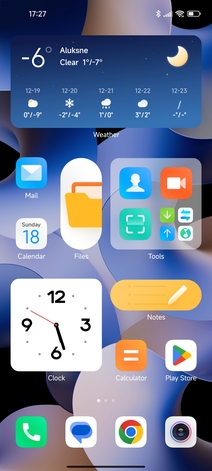| Developer | Xiaomi |
|---|---|
| OS family | Android-like OS (Android-based Linux OS) |
| Source model | Open source (Modified Android Base and Main Framework) with Proprietary components (MIUI Apps and Kits)[1] |
| Initial release | 0.8.16 / 16 August 2010 |
| Latest release | Varies by mobile phone and region. |
| Latest preview | V14.0.23.10.8.DEV (Mainland China) / 17 August 2023 |
| Marketing target | Alternative OS replacement for Android devices; Stock firmware for Xiaomi smartphone and tablet |
| Available in | 77 languages (varies by country) |
| Package manager | APK-based |
| Platforms | ARMv7, ARM64, MIPS, x86, x64 |
| Kernel type | Monolithic (modified Linux kernel) |
| License | Proprietary |
| Succeeded by | Xiaomi HyperOS |
| Official website | www home |
MIUI[a] is a deprecated mobile operating system by Xiaomi for its smartphones and devices, from 2010 to 2023,[3][4][5] prior to the launch of its successor Xiaomi HyperOS.[6]
MIUI was based on the Android Open Source Project, and served as the basis for other OS deviations by Xiaomi: MIUI for Poco, MIUI Pad, MIUI Watch, and MIUI TV (PatchWall).[7]
There are different versions for each Xiaomi phone model, and each version has regional variants dependent on where the phone is sold, including China, Europe, Indonesia, India, Japan, Pakistan, Russia, Taiwan and Turkey. Xiaomi have also released a few devices running Google's Android One instead of MIUI. Xiaomi devices usually get three Android version updates, but get MIUI updates for four years (less for budget models).[8]
The first MIUI ROM, released in 2010, was based on Android 2.2.x Froyo and was initially developed in China by Xiaomi in its first year of operation.[9] Xiaomi added a number of apps to the basic framework, including Notes, Backup, Music, and Gallery apps.[10]
An organisation named Xiaomi Europe, using the domain xiaomi.eu and working officially with Xiaomi despite not being affiliated with the Chinese company,[11] was set up in 2010 as a community for English-language Xiaomi users with phones running MIUI associated with an Android version. The website issues its own stable and weekly versions of Xiaomi MIUI ROMs based on the stable, and on the weekly beta versions of the Chinese ROM.[11] Installing the xiaomi.eu ROM, however, voids the warranty on Xiaomi phones; according to the xiaomi.eu leader, the official ROM must be flashed and the bootloader locked before returning a device for warranty repair.[12]
Xiaomi is replacing MIUI with its new Android-based operating system HyperOS, starting with the Xiaomi 13 series and Pad 6.[13]
- ^ "Mi OpenSource". github.com.
- ^ About MIUI Video on YouTube
- ^ Xiaomi 13 Quick Start Guide
- ^ "小米科技的MIUI和手机_通讯与电讯_科技时代_新浪网". tech.sina.com.cn. Archived from the original on 2 February 2019. Retrieved 24 April 2012.
- ^ MIUI Official English Site, en.miui.com, archived from the original on 15 February 2014, retrieved 16 March 2014
- ^ "Xiaomi HyperOS".
- ^ Xiaomi Mi Watch is unapologetically inspired by the Apple Watch, but costs only $185
- ^ Xiaomi Phone with MIUI OS: a $310 Android with 1.5 GHz dual-core SoC and other surprises, Engadget, 16 August 2011, archived from the original on 23 September 2011, retrieved 17 September 2011
- ^ Jason Lim (14 April 2011), MIUI, Lei Jun, TechNode, archived from the original on 2 April 2019, retrieved 17 January 2012
- ^ "MIUI Official English Site". Archived from the original on 9 April 2014. Live version for current MIUI; archived version for MiUI 5.
- ^ a b "Home page, with 'About us' and forum list". Xiaomi European Community. Archived from the original on 27 April 2021. Retrieved 22 June 2023. Updated frequently.
- ^ ingbrzy, Xiaomi.eu ROM leader (24 January 2021). "Answer to: Do I have warranty after flashing xiaomi.eu?". Xiaomi European Community. Archived from the original on 28 April 2021.
- ^ "Xiaomi HyperOS". Xiaomi. Retrieved 8 November 2024.
Cite error: There are <ref group=lower-alpha> tags or {{efn}} templates on this page, but the references will not show without a {{reflist|group=lower-alpha}} template or {{notelist}} template (see the help page).
